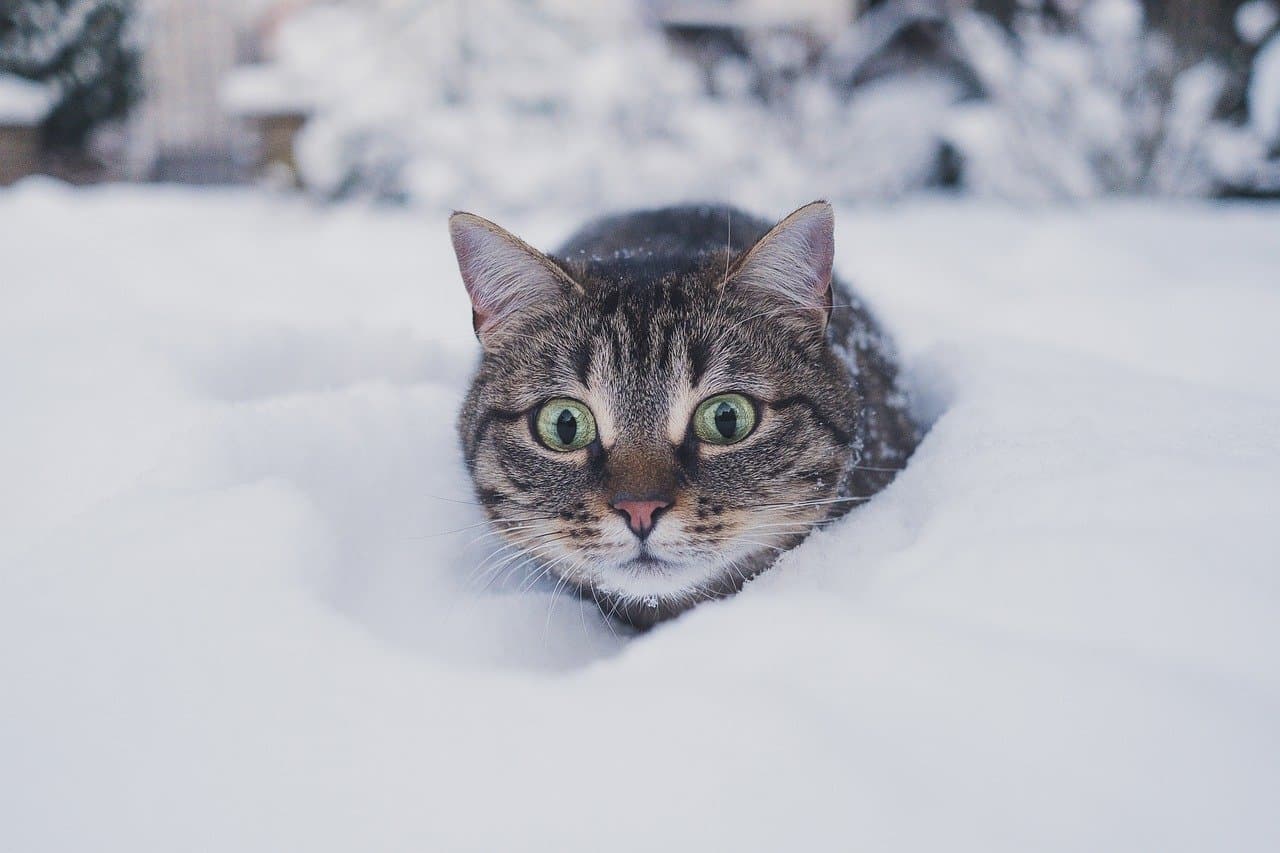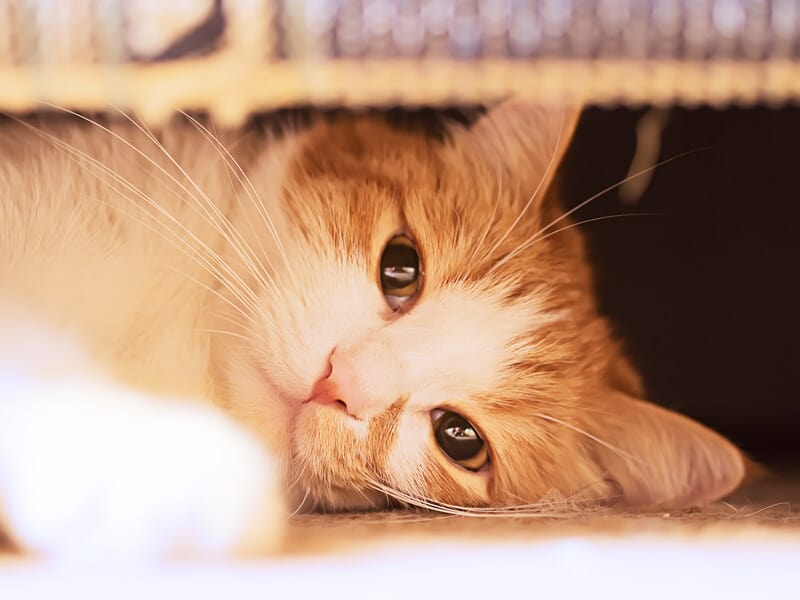We all know cats love warm places, but what about the cold? Do cats easily get cold? Can they keep warm? If you care about your cat’s wellbeing, you will have asked yourself whether cats get cold, especially if your kitty likes to go outside.
As a general rule, cats are fairly resistant to cold because their fur protects them from low temperatures. Healthy cats can keep themselves warm until temperatures reach freezing (32°F / 0°C), while elderly cats and kittens are at risk below 45°F / 7°C. Prolonged exposure to low temperatures can be dangerous to cats.
Their thick fur coat goes a long way in protecting your fur baby from the cold, but there are situations where cats are at risk of hypothermia.
Let’s explore and see when your cat might need a bit of help to stay warm and avoid problems with their health.
Do cats get cold easily?
There are many different breeds of cats, and some are more resistant to cold than others.
Cat breeds like the Maine Coon and Turkish Angora have long and thick fur that will help them keep warm. However, cats with little or no hair, like the Sphynx and Peterbald, will have a harder time maintaining their temperature.
Because cats have evolved over many centuries to adapt to their natural environment, they are perfectly suited to survive in their natural habitat.
Like the Norwegian Forest cat, cats who have evolved in colder regions will have a thicker coat than cats who primarily live in warmer regions like, for example, a Bengal cat.
So, it’s safe to say that cats in their natural environment don’t get cold easily. However, as a result of breeding or moving cats to live in colder places that are not natural, keeping warm might be more challenging for them.
Also, cats who grew up to live primarily indoors may not be used to colder temperatures, even if they would originate in colder regions.
How cold is too cold for cats?
Generally speaking, prolonged exposure to temperatures below 45ºF / 8°C could already be too for a cat.
However, some cats are more resistant to cold than others, depending on the factors below;
- Age: Kittens need to keep warm because they haven’t yet developed the ability to regulate their body temperature. Even under normal circumstances, kittens are kept warm by their mother and each other’s body heat. On the other hand, older cats (above the age of 10 years) can suffer from arthritis which will worsen under cold temperatures. Their coat tends to be thinner at older age which also impacts their temperature regulation.
- Breed: Cats with thick and fluffy coats will be more resistant to cold than cats with thin or little fur. Likewise, larger breeds and cats with more body fat can maintain their body temperature better than smaller cat breeds.
- Environment: Cats used to spending time outside can also tolerate lower temperatures than cats who live their lives primarily indoors. Not only will their bodies have adapted to managing cold, these cats generally eat more to stay warm and have learned to take shelter outside when it gets too cold.
- Body mass: Body mass plays an important role when it comes to regulating temperature. The same as with humans, cats with a larger body mass will have less of an issue staying warm. Especially body fat will insulate against cold.
- Diet: Cats who regularly go outside and spend time in cooler places or climates tend to be bigger eaters as well. To regulate their body temperature and stay warm, their bodies need more energy than indoor cats. Additionally, the build-up of body fat will also help to fight off cold.
What’s the ideal temperature for cats?
Taking into account factors like age, breed, body mass, fur density, and diet, cats can comfortably survive in temperatures between 50°F and 90°F / 10°C and 33°C. For indoor cats, the ideal temperature is at the higher end of that range, while outdoor cats can tolerate lower temperatures, provided they have a place to shelter, especially in winter weather.
Cats have a body temperature that is slightly higher than ours. The average human body temperature is about 98°F, whereas, for cats, this sits between 100°F and 102.5°F.

What to do during frigid winter months?
Some outdoor cats will want to go outside at all costs, and they will demand to go outside, even during a harsh winter.
If your furball regularly goes outside during cold weather, they will know how to keep themselves warm and when to come back inside to warm up.
On the other hand, it’s good to keep an eye on them and not leave your feline out for too long or during the night.
Because of their small size, they burn more energy to maintain their ideal temperature compared to larger animals. For that reason, outdoor cats usually take more food during winter months and sometimes develop a denser fur compared to their indoor companions.
How long can cats stay outside during winter?
A cat in good health that is used to going outside, even during winter, will require a greater amount of food. To keep warm outside, your cat will stay active and, as mentioned, burn more calories to maintain its body temperature.
It’s also not uncommon to notice your cat’s fur getting thicker when spending time outside in the cold.
For this reason, cats are generally pretty well-suited to spend some time outside in the cold, and you shouldn’t worry too much.
A cat’s instinct for self-preservation is very strong, and they will look for shelter or decide to come back inside if they get cold.
If you have the opportunity to create a shelter for your cat, like a place in a shed or garage they can access, that’s great.
Otherwise, as a rule of thumb, we’d advise not to let leave them outside for more than a couple of hours and keep them inside during the night.
What are the signs of hypothermia in cats?
Although cats are pretty good at keeping themselves warm, there is a risk of becoming hypothermic if exposed to cold temperatures for too long.
Here are some common symptoms to look out for and could indicate your cat is suffering from hypothermia.
- Weakness or trouble moving around
- Lethargic
- Chills and shivering
- Cold to the touch, especially the nose, ears, and paws
- Trouble breathing
- Seeking warmer places
Elderly or sick cats are at higher risk of hypothermia and may exhibit even mild symptoms without spending time outside.
What to do if your cat is suffering from hypothermia
The most important thing to do in this case is to get them warmed up.
Be careful though; although they need warmth urgently, do not expose your cat to sudden and abrupt heat! Instead, make sure they can warm up slowly but surely.
Great ways to warm your cat are:
- Hold them close to you, under a coat or blanket to provide person-to-person body heat.
- Wrap your cat in a blanket; if possible, pre-heat a blanket in your dryer.
- Use a heating pad or a bottle with warm water as a heat source.
- It’s best not to get your cat wet; however, if she’s already wet (e.g., she fell in the water), you can give her a warm bath. Just make sure to dry her well.
These are considered “first-aid” actions essential for hypothermic cats; however, after you get your cat’s temperature stabilized, she needs medical attention.
Hypothermia in cats can be dangerous, even life-threatening. After warming up, cats need to be examined by a veterinarian. In severe cases, your cat might need fluid therapy to survive.

Are some breeds more likely to get cold / hypothermic?
Well, to be honest, there is no such thing as a specific breed of cats that may suffer from hypothermia more than others.
However, as we have seen so far, several breeds are naturally more “prepared” to resist cold than others.
Based on their anatomy, cats with long hair like the Norwegian Forest cat, Maine Coon, Siberian, Scottish Fold, Ragdoll, and Himalayan are more resistant to cold.
On the other hand, cats used to warm conditions or that naturally live in arid places will not endure cold easily. Some breeds that live in those areas are Sphynx, Egyptian Mau, and Peterbald.
How to keep indoor and outdoor cats warm during winter
There are several tricks you could use to keep your cat warm during winter. Let´s take a look at some of them:
Look for the sun
Cats love to stay under the Sun so that they can enjoy a good nap. Even the winter sun can provide warmth, and your cat will love sunbathing behind glass.
Open the curtains to allow the sun inside during the day, and place cat beds in front of the windows. You can also place feline scratching trees in bright and warm areas.
Heated cat beds
According to your cat, a heated cat bed is probably the best invention after the internet.
These work is similar to electric blankets that we might use to get warm and snug in bed and keep the cat bed warm and inviting.
Exercise and food
Physical activity will also help keep you warm during the winter. Not only by them moving around, but it also improves their blood circulation.
Set aside some time to play with your cat every day. It’s good and healthy for more reasons than just keeping warm.
A healthy, balanced, protein-rich food is essential for cats, especially during winter. Make sure there is a healthy mix between wet and dry food.
What about summer? – Can cats get too hot?
Apart from making sure your cat keeps warm during winter, in summer, it’s a good idea to keep an eye on your cat as well.
Usually, cats are good at managing their body temperature, but, like dogs, cats are at high risk of having a heat stroke.
Provide your kitty with opportunities to keep cool during the warmest summer days by providing shadow, ventilation, and plenty of fresh water within reach. If you have air conditioning, it’s a good idea to allow your cat to cool down in an air-conditioned room.





